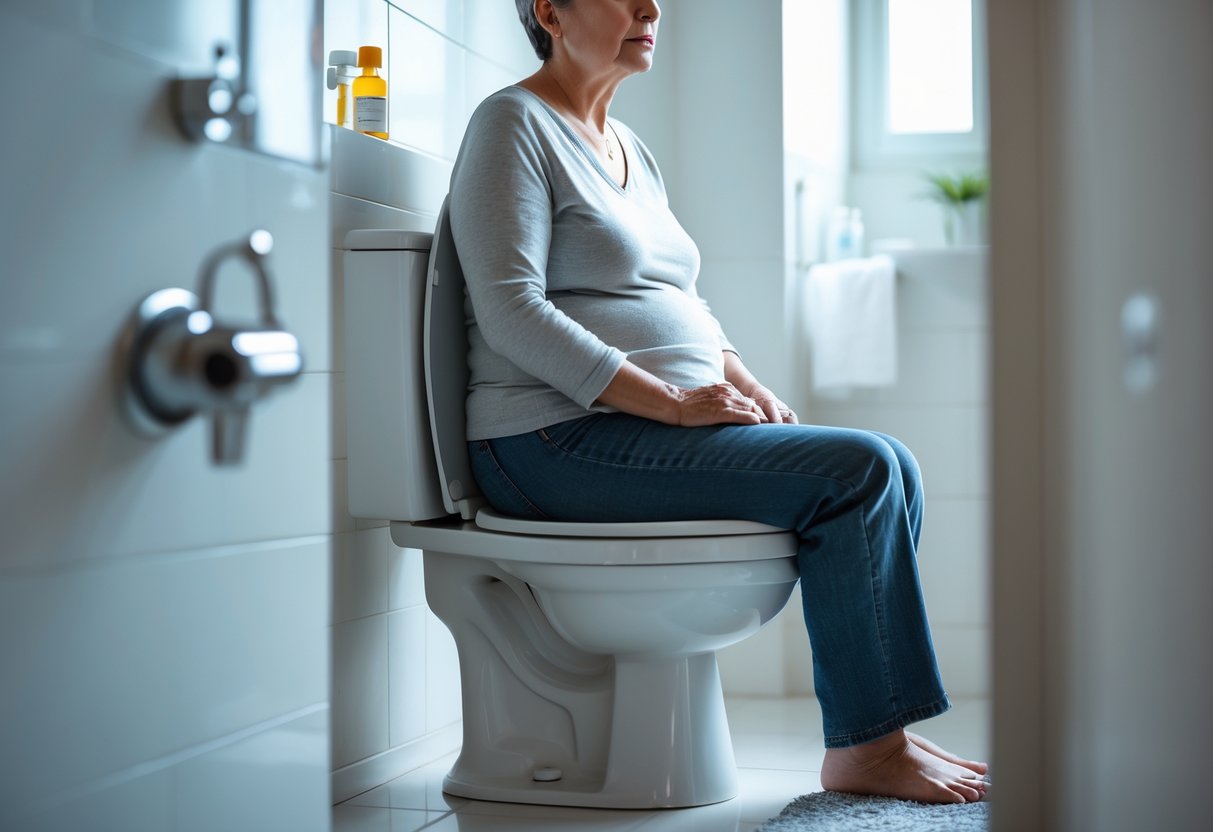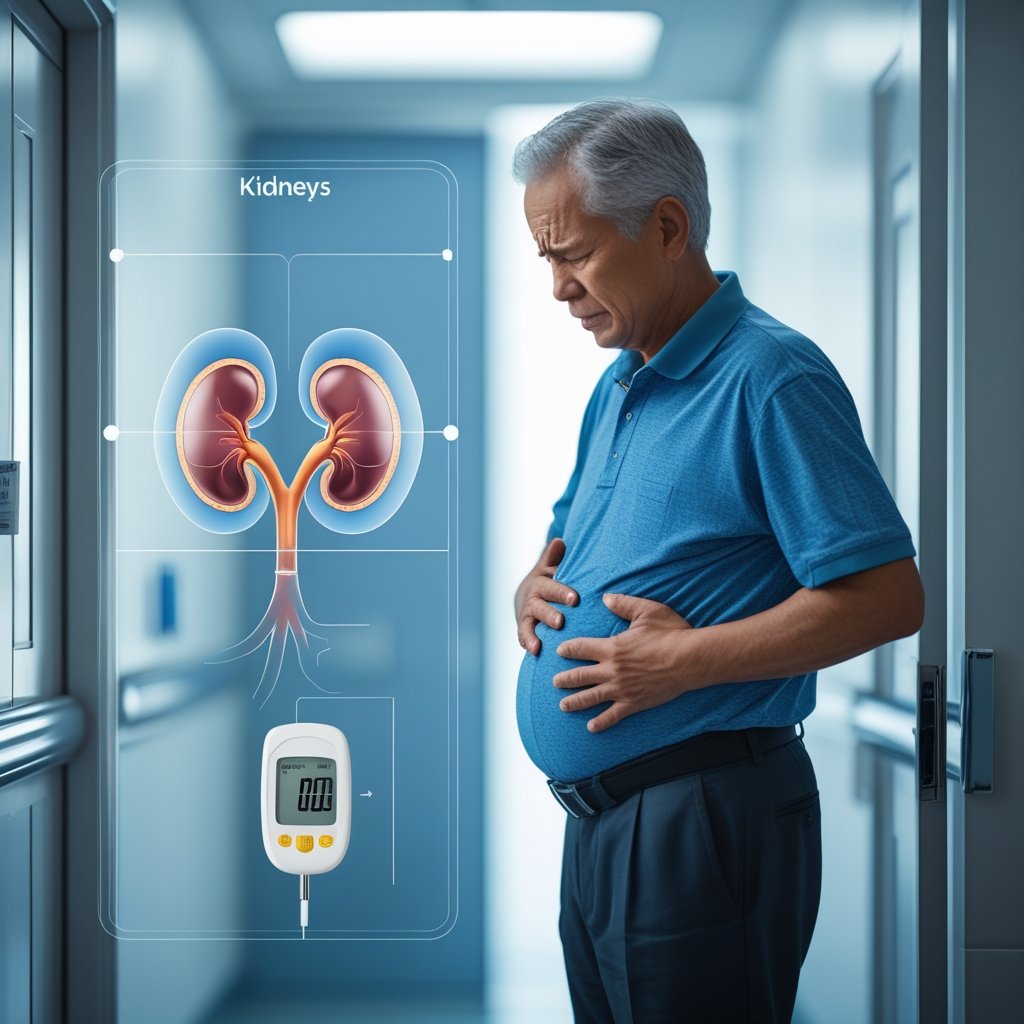Going to the bathroom more often than usual? It can be frustrating and really mess with your daily routine. Most folks don’t realize that those constant trips might mean something more is going on with their health.

Frequent urination is a common early symptom of diabetes that pops up when high blood sugar levels push the kidneys to filter out extra glucose from the blood. When blood sugar climbs too high, the kidneys can’t keep up, so they dump the excess glucose into urine. All this sugar drags more water along for the ride, so you end up peeing more than usual.
If you start noticing changes in how often you need the bathroom, it might help to understand what’s going on inside your body. High blood sugar kicks off a cycle: increased thirst makes you drink more, which just means even more trips to the restroom.
Key Takeaways
- High blood sugar makes kidneys flush out extra glucose, which pulls more water and bumps up bathroom visits
- Frequent urination often tags along with increased thirst and tiredness as early diabetes warning signs
- Managing diabetes well can lower urinary symptoms and help dodge bigger complications
How Diabetes Causes Frequent Urination

Diabetes sets off a chain reaction that starts with high blood sugar levels. When glucose piles up in the blood, the kidneys start working overtime to kick out the extra sugar, which means pulling more water into the urine, too.
The Role of Blood Sugar in Urine Production
High blood sugar directly ramps up urine production if you have diabetes. When glucose in your blood goes above normal, your body tries to fix things by flushing out the excess sugar.
High blood sugar throws off normal kidney function and pushes these organs to deal with more fluid than they’re used to. Usually, kidneys reabsorb most of the water they filter, but high glucose levels get in the way.
Blood sugar above 180 mg/dL usually makes glucose spill into the urine, but this number isn’t set in stone for everyone. Most people start noticing bathroom changes when their blood sugar stays high for a while.
As you lose more fluid through urination, dehydration sets in, which makes you thirsty—so you drink more, and, well, you know what happens next.
Polyuria Explained
Polyuria is the fancy medical term for making way too much urine—over 2.5 liters a day for adults. It’s honestly one of the most common diabetes symptoms out there.
What polyuria looks like:
- Needing to pee more than 8 times a day
- Letting out big amounts every time
- Waking up several times at night to go
- Feeling like you have to go right after drinking something
In rough cases, you could be producing anywhere from 3 to 15 liters a day—seriously. Why? Because glucose acts like an osmotic diuretic, pulling water into the urine with it.
For a lot of people, polyuria is the first sign something’s up. It tends to sneak up as your blood sugar stays high.
Kidneys and Glucose Filtration
Your kidneys play a big part in keeping blood glucose in check. They’ve got millions of tiny filters—nephrons—that sort out your blood and get rid of waste.
Normally, kidneys filter out glucose but then suck almost all of it back into your blood. If there’s too much sugar, though, the kidneys can’t keep up and the overflow ends up in your urine.
Here’s how the process works:
- Blood flows into the kidney through the renal artery
- Nephrons filter out glucose and other stuff
- Most glucose gets reabsorbed into the blood
- But if there’s too much, the rest spills into urine
If high blood sugar sticks around, kidneys can get damaged, making urination issues even worse. Diabetes can also mess with nerves in the urinary tract, which leads to more bladder drama.
Each person’s kidneys have a threshold for how much glucose they can handle. Once you cross it, sugar keeps showing up in your urine and the frequent urination just doesn’t let up.
Common Symptoms and Warning Signs

Frequent urination in diabetes usually comes bundled with other symptoms. High blood sugar makes kidneys work harder, which means more urination, crazy thirst, and, honestly, feeling wiped out.
Excessive Thirst and Dehydration
More thirst and more bathroom trips go hand in hand when your blood sugar’s high. When glucose piles up, kidneys can’t catch it all, so the extra sugar gets dumped into urine along with water from your tissues.
This process leads to dehydration all over your body. Suddenly, you’re way thirstier than usual—some people say it feels like nothing can quench it.
You drink more to try to fix it, but then end up peeing even more. It’s a loop that just doesn’t quit.
Diabetes thirst is usually:
- Persistent – sticks around even after drinking
- Intense – stronger than your average thirst
- Constant – can last all day and night
Urination Frequency and Nocturia
Frequent urination is often the first thing people notice. You might find yourself in the bathroom every hour or two, and it’s not just during the day.
Nocturia means waking up a bunch of times at night to pee. Lots of folks with diabetes end up getting up three, four, even five times, which can wreck a good night’s sleep.
Some of the changes you’ll spot:
- Bigger amounts of urine each time
- Way more trips to the bathroom
- That gotta-go-now feeling
- Struggling to hold it in
It’s normal to visit the bathroom a bit more as you age, but if it’s suddenly happening a lot, or the volume is way up, diabetes could be the reason.
Associated Fatigue and Other Symptoms
Diabetes can leave you feeling completely drained. High blood sugar messes with your cells’ ability to use glucose for energy, so you feel tired even if you think you’ve rested enough.
All that extra urination dries you out, too, taking important fluids and electrolytes with it. No wonder you feel so sluggish.
Other symptoms that crop up with frequent urination:
| Symptom | Description |
|---|---|
| Blurry vision | High blood sugar messes with fluid in the eye lens |
| Unexplained weight loss | You lose calories as sugar leaves your body in urine |
| Increased hunger | Cells can’t get the glucose they need for energy |
| Slow-healing cuts | Poor blood flow makes healing take longer |
These symptoms can sneak up on you, sometimes taking weeks or months to really show up. It’s easy to blame the tiredness on stress or just getting older, so people often miss the early signs.
Types Of Diabetes and Related Urinary Issues
The kind of diabetes you have changes how your bladder acts up. Type 2, for example, causes over half of adults to deal with bladder problems. Each type brings its own set of challenges, thanks to blood sugar swings and the meds involved.
Type 1 and Type 2 Diabetes
Type 1 diabetes happens when your body just can’t make insulin. If you have it, you’ll probably notice more bathroom trips, since your kidneys work overtime to clear out all that extra glucose.
No insulin means glucose builds up fast, and your kidneys have to drag more water into your urine to get rid of it.
Type 2 diabetes can mess with your bladder in more than half of adults who have it. Insulin resistance means your cells can’t use glucose the way they’re supposed to.
How the symptoms differ:
- Type 1: Sudden onset of frequent urination, especially in kids and young adults
- Type 2: Bladder issues build up slowly, sometimes with incontinence mixed in
- Both types: Nighttime urination and being really thirsty
Type 2 is often behind overactive bladder and urinary tract infections. Nerve damage and high blood sugar combine to make things worse.
Prediabetes and Early Warning Signs
Prediabetes means your blood sugar’s higher than it should be, but not quite in the diabetes zone. You might spot some changes in how often you need to go, but they’re usually subtle at first.
Frequent urination can show up early, sometimes before you even get diagnosed. If your blood sugar sits between 100–125 mg/dL, you might already notice some shifts.
Early warning signs:
- Going more than 8 times a day
- Getting up two or more times at night to pee
- Thirst that sticks around, plus frequent urination
- Cloudy or sweet-smelling urine
These changes build up slowly, so it’s easy to chalk them up to aging or stress. But if you catch prediabetes early, you can make changes to stop it from turning into full-blown diabetes.
Effects of Diabetes Medications
Different diabetes medications affect urinary function in all sorts of ways. Some meds actually ramp up urination as part of how they control blood sugar.
SGLT2 inhibitors force your kidneys to flush out extra glucose through urine. So, if you’re taking these, expect more frequent and larger bathroom trips.
Diuretics sometimes get prescribed alongside diabetes meds for blood pressure issues. They basically add to the problem by pulling even more fluid from your system.
Common medication effects:
| Medication Type | Urinary Effect | Reason |
|---|---|---|
| SGLT2 inhibitors | Increased frequency | Glucose removal through urine |
| Diuretics | More volume | Fluid removal for blood pressure |
| Insulin | May reduce frequency | Better glucose control |
Insulin therapy can actually help with urinary symptoms. When blood sugar’s under control, the kidneys don’t have to work as hard, so you might not run to the bathroom as much.
Sometimes, people need to tweak their meds to balance blood sugar and urinary comfort. Docs can adjust timing or doses to keep bathroom breaks from taking over your day.
Complications and Underlying Causes
High blood sugar from diabetes doesn’t just mean more trips to the bathroom. It can lead to infections, nerve damage, and loss of bladder control—none of which are fun.
Urinary Tract Infections
People with diabetes face a bigger risk of urinary tract infections. High glucose in urine gives bacteria a perfect place to hang out and multiply.
The immune system also doesn’t pull its weight when blood sugar stays high. That makes it tougher to fight off urinary infections.
Women with diabetes get UTIs more often than men. The shorter female urethra just makes it easier for bacteria to reach the bladder.
Common UTI symptoms include:
- Burning sensation during urination
- Cloudy or strong-smelling urine
- Pelvic pain in women
- Fever and chills in severe cases
Diabetes-related bladder problems need close watching because infections can get serious fast. If you let a UTI go, it might even reach your kidneys and cause lasting damage.
Overactive Bladder and Nerve Damage
Diabetes can mess with the nerves that control your bladder. This kind of nerve damage, called diabetic neuropathy, changes how your bladder fills and empties.
When those nerves go haywire, the bladder might contract at the wrong times. Suddenly, you feel like you have to go—even if the bladder’s barely got anything in it.
High blood sugar over the years is what causes this nerve trouble. The longer diabetes goes uncontrolled, the more likely it’ll mess with your bladder nerves.
Nerve damage symptoms include:
- Sudden urgent need to urinate
- Bladder spasms
- Difficulty sensing when the bladder is full
- Incomplete bladder emptying
Sometimes, it’s the opposite—the nerves don’t trigger contractions, so urine just sits around too long in the bladder. That’s not great either.
Bladder Control Challenges
Diabetes can cause all sorts of bladder control issues—not just more frequent peeing. These problems can really mess with daily life and sleep.
Neurogenic bladder pops up when nerve damage blocks normal bladder function. The bladder might not empty fully, and leftover urine just ups your infection risk.
Some folks lose the ability to even notice when their bladder’s full. That can lead to accidents or overflow incontinence, where urine leaks out constantly.
Bladder control problems include:
- Inability to hold urine
- Leaking between bathroom trips
- Difficulty starting urination
- Weak urine stream
Poor blood sugar control just makes all these issues worse. Managing diabetes well can help prevent more nerve damage—and maybe even improve some bladder problems you already have.
Managing Frequent Urination With Diabetes
If you’ve got diabetes, you can try a bunch of things to cut down on those urgent bathroom runs. Diet tweaks, bladder training, targeted exercises, and lifestyle changes all help. Still, keeping blood sugar in check is the big one for controlling urinary symptoms.
Dietary Adjustments and Hydration
What you eat and drink really matters when it comes to frequent urination. People with diabetes should stick to foods that help keep blood sugar steady.
Blood Sugar Control Foods:
- Whole grains instead of refined carbs
- Lean proteins—think chicken, fish, beans
- Non-starchy veggies like spinach and broccoli
- Healthy fats from nuts and olive oil
Certain drinks can make you pee more. Caffeine and alcohol act as diuretics, so they’re worth limiting if bathroom trips are driving you nuts.
Drinks to Limit:
- Coffee and tea after 2 PM
- Sodas and energy drinks
- Alcoholic beverages
- Artificial sweeteners that might irritate your bladder
It’s not just how much you drink, but when. Try to drink more fluids earlier in the day so you’re not up all night running to the bathroom.
Timed Voiding and Bladder Training
Bladder retraining can help you regain control over your bathroom habits. Basically, you teach your bladder to hold more urine for longer stretches.
Timed Voiding Schedule:
- Start by peeing every 2 hours during the day
- Stretch the interval by 15-30 minutes each week
- Work up to 3-4 hours between trips
- Try relaxation techniques when you get that urgent feeling
This takes patience and some stubbornness. Most people see a difference after a couple months of sticking with it.
Training Tips:
- Keep a bathroom diary—yes, really
- Breathe deeply when you feel the urge
- Distract yourself with something else
- Don’t rush to the bathroom the second you feel it
Pelvic Floor Exercises
Strengthening your pelvic floor muscles can make a big difference in bladder control and leakage. Both men and women with diabetes can benefit from these exercises.
Kegel Exercise Steps:
- Find the right muscles—try stopping urination midstream (just to identify them, not as a regular habit)
- Squeeze for 3 seconds
- Relax for 3 seconds
- Repeat 10-15 times, three times a day
Technique matters. You want to feel those muscles lift and squeeze, but don’t tense up your butt, thighs, or stomach.
Progressive Training:
- Week 1-2: Hold for 3 seconds
- Week 3-4: Hold for 5 seconds
- Week 5-6: Hold for 10 seconds
- Stick with 10-second holds after that
Most people notice results after 6-8 weeks if they keep at it. Sometimes a physical therapist who specializes in pelvic floor training can really help too.
Lifestyle Changes and When to Seek Medical Advice
Other lifestyle tweaks can help with frequent urination, too. Managing your weight makes a real difference for blood sugar and bladder function.
Effective Lifestyle Changes:
- Keep a healthy weight with diet and exercise
- Quit smoking (it just irritates your bladder)
- Try meditation or yoga to manage stress
- Wear loose clothes to avoid putting pressure on your belly
Regular exercise helps control blood sugar and strengthens the core muscles that support your bladder. Walking or swimming are usually good options.
Medical Attention Warning Signs:
- Burning when you pee
- Blood in urine
- Fever or chills
- A sudden spike in urination frequency
- Can’t control urination at all
Doctors can prescribe meds for overactive bladder or treat infections if needed. Some folks might need more advanced treatments like bladder injections or nerve stimulation therapy.
If urinary problems stick around, talk to your diabetes care team. Catching things early can save you a lot of hassle down the road.
Frequently Asked Questions
People with diabetes often notice changes in how often they need to pee, usually because high blood sugar messes with kidney function. Understanding this connection helps you know when it’s time to call your doctor.
What are the common causes of frequent urination in individuals with diabetes?
High blood sugar makes your kidneys work overtime to filter out extra glucose. When they can’t reabsorb all the sugar, you end up peeing more to get rid of it.
This process also drains fluids from your body. That’s why people with diabetes often feel thirsty and still keep running to the bathroom.
Frequent urination is usually a sign blood sugar isn’t well controlled. Both type 1 and type 2 diabetics can have this issue if their glucose stays high.
How can nighttime urination be managed for those with diabetes?
Nighttime urination happens when blood sugar stays high overnight. People with poorly controlled diabetes might get up several times because their bodies are still trying to flush out that extra glucose.
Getting blood sugar under control is the best way to cut down on nighttime bathroom trips. Just drinking less water before bed won’t help if your glucose is still high.
Your doctor can help adjust meds to keep overnight blood sugar steady. Regular monitoring helps you spot patterns that might be causing all those late-night bathroom runs.
What non-diabetic conditions can lead to increased thirst and urination?
Plenty of things besides diabetes can make you pee more. Pregnancy, overactive bladder, anxiety, and urinary tract infections all do it.
UTIs irritate your bladder and make you feel like you need to go constantly. Pregnancy puts extra pressure on the bladder as the baby grows.
Some meds also increase urination. And, well, drinking a lot of fluids will naturally have you running to the bathroom more often.
Is there a link between low blood sugar levels and frequent urination?
Low blood sugar doesn’t usually make you pee more. Frequent urination is a sign of high blood sugar, not low.
When blood sugar drops too low, you might feel shaky, sweaty, confused, or get a rapid heartbeat—but not the urge to pee.
High blood sugar tells the kidneys to make more urine to flush out glucose. Low blood sugar doesn’t trigger that reaction at all.
What urinary complications can arise from diabetes?
Diabetes can damage the nerves that control bladder function as time goes on. When those nerves don’t work well, it’s just harder to empty your bladder completely—or even know when you need to go.
High blood sugar makes urinary tract infections more likely. People with diabetes face higher risks of infections, including those affecting the urinary system.
Kidney damage from diabetes creeps up slowly. The kidneys might lose their knack for filtering waste and keeping your body’s fluids balanced.
How does diabetes affect urine color and other characteristics?
High blood sugar can make urine look cloudy and give it a sweet or fruity smell. Extra glucose in the urine causes these changes, and honestly, you might notice it before anything else.
Usually, urine looks pale yellow and barely smells at all. But when diabetes isn’t well managed, the odor can get stronger because of all that glucose and sometimes ketones sneaking in.
If your urine turns dark, red, or you spot blood, don’t wait—get medical attention right away. Those changes can signal something serious that needs a doctor’s eye.



Pingback: Is Beetroot Good for Diabetes? Health Impact, Glycemic Index & Benefits - Pharma Heals
Pingback: Diabetes 2 Symptoms Men: Early Warning Signs and Key Health Indicators to Watch For - Pharma Heals